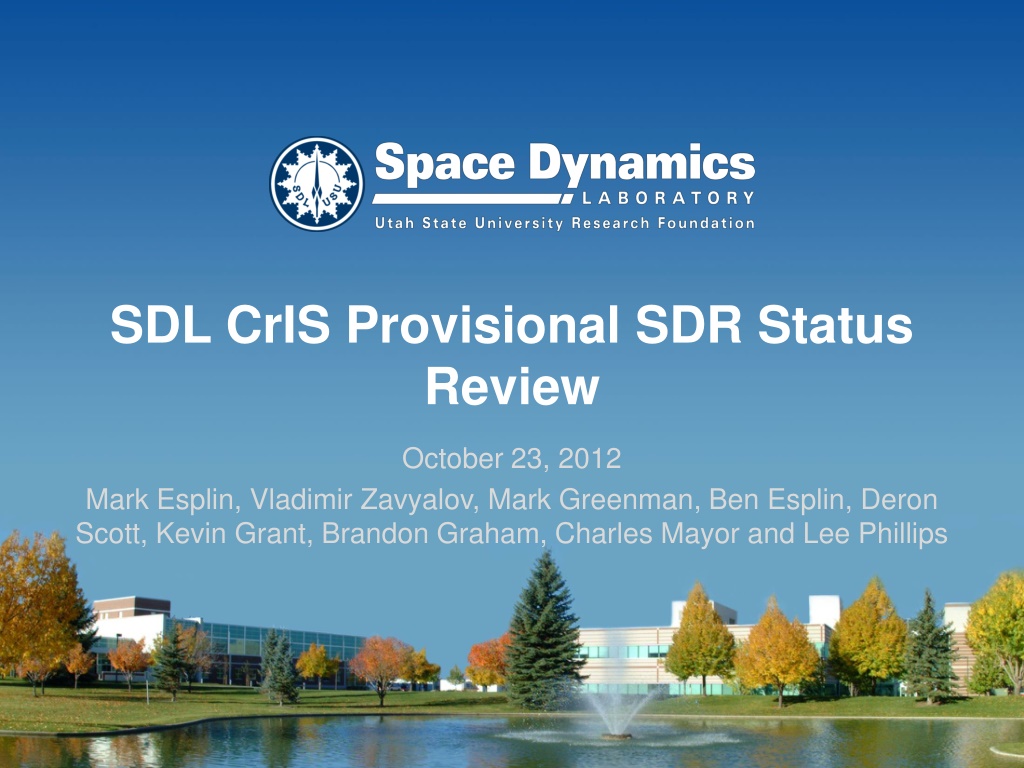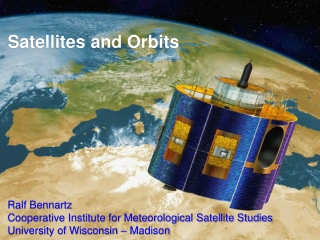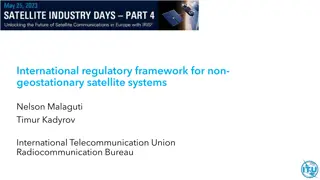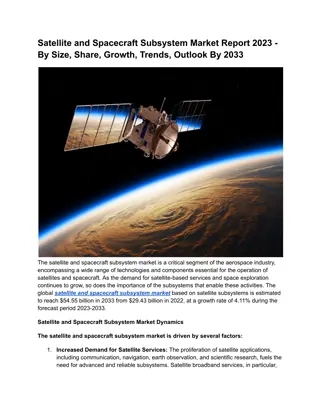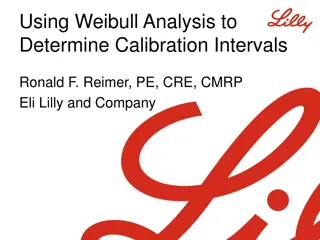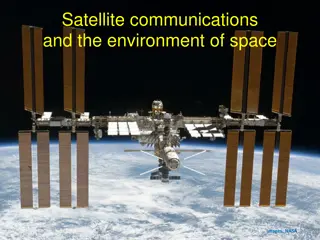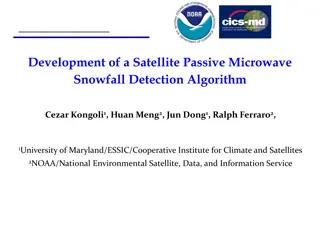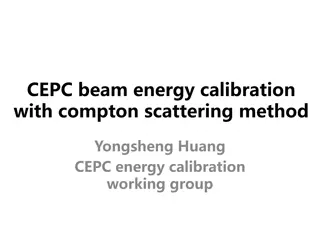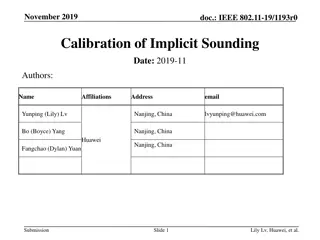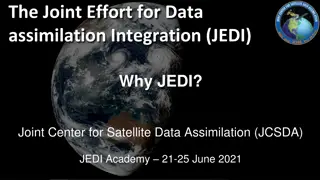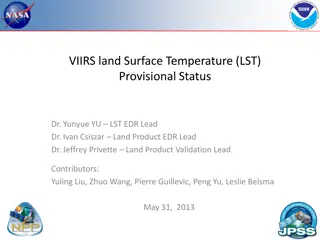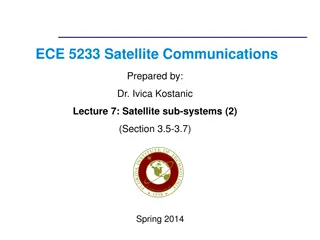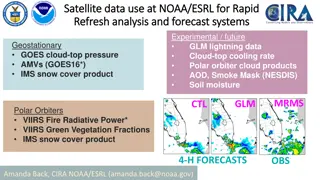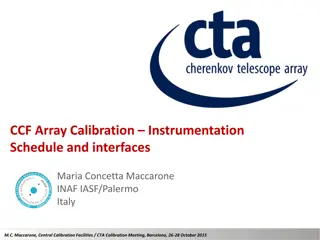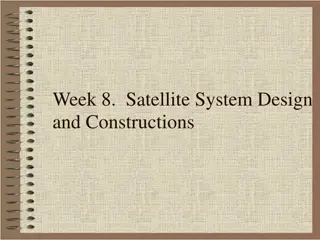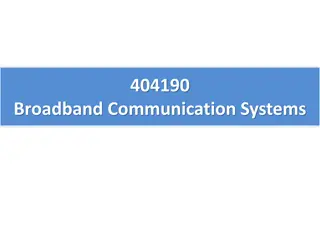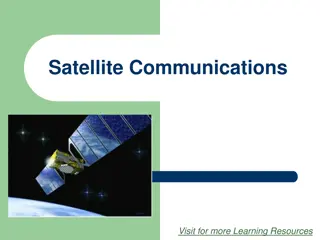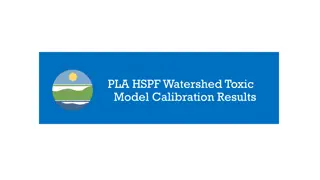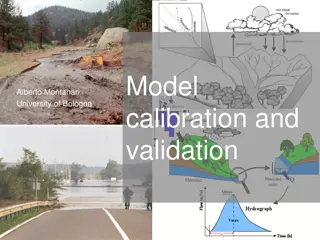Satellite Data Review and Calibration Analysis
Review of the SDL.CrIS provisional SDR status, completion of various CrIS cal/val tasks, and detailed assessments of different bit-trim masks for satellite interferometer optimization, with findings on bit-trim errors, interference analysis, and mask adjustments.
Download Presentation

Please find below an Image/Link to download the presentation.
The content on the website is provided AS IS for your information and personal use only. It may not be sold, licensed, or shared on other websites without obtaining consent from the author. Download presentation by click this link. If you encounter any issues during the download, it is possible that the publisher has removed the file from their server.
E N D
Presentation Transcript
SDL CrIS Provisional SDR Status Review October 23, 2012 Mark Esplin, Vladimir Zavyalov, Mark Greenman, Ben Esplin, Deron Scott, Kevin Grant, Brandon Graham, Charles Mayor and Lee Phillips
SDL Cal/Val Tasks CrIS Task #1 Interferometer Optimization (Completed) CrIS Task #3 Amplifier Gain Check and Adjustment (Completed) CrIS Task #4 Bit Trim and Impulse Mask Check (Completed for present resolution, assessing full resolution bit-trim mask) CriIS Task #5 Radiometric Noise Assessment (NEdN) CrIS Task #8 Geolocation Calibration CrIS Task #9 ICT External Environmental Model Tuning CrIS Task #12 Spikes and Saturated Interferogram Analysis CrIS Task #13 Ice Contamination Analysis CrIS Task #14 Correlated/Uncorrelated noise characterization 2
CrIS Task 4: Bit-Trim and Impulse Mask Check OBJECTIVE: Insure that the bit-trim and impulse masks are set properly DESCRIPTION: Search data for occurrences of bit-trim and impulse mask errors Find very warm scenes Find maximum magnitude of interferograms for each displacement position Insure maximum interferogram values are below bit-trim mask Evaluate bit-trim masks for adequate margins RESULTS: The bit-trim mask is properly set for CrIS present resolution Impulse mask errors are rare and are properly flagged in the SDR when they occur Evaluation of the proper bit-trim mask for the full resolution data is ongoing
Present LWIR Bit-Trim Mask Absolute value of maximum interferogram at each position Launch bit-trim mask was inadequate Present bit-trim mask shows margin against bit-trim errors Hot scenes (orbit 01444 over Australia) (Feb 7, 2012) 4
Full Resolution MWIR Bit-Trim Mask On-orbit test bit-trim mask excessively conservative Extended present bit-trim mask shows margin Orbit 1671 over Australia (February 23,2012) Australian outback very warm in February 5
Full Resolution SWIR Bit-Trim Mask On-orbit test SWIR bit-trim mask wasteful of bandwidth Interferogram would saturate before hitting bit-trim mask Extended present bit-trim mask has margin Orbit 1671 over Australia (February 23,2012) 6
CrIS Task 5: Radiometric Noise Assessment TASK LEAD: SDL OBJECTIVE: Characterize the CrIS NEDN and its trending over time DESCRIPTION: NEdN is calculated using a minimum of 300 interferogram measurements of ICT and DS targets for each FOV Random component of the NEdN is also estimated analyzing Earth Scene (ES) data through the PCA tools and compared with NEdN estimated using ICT and DS data Compare on-orbit NEdN to ground-based measurements and predicted performance Trend NEdN performance through different phases of Cal/Val Cal/Val phases: All Data type: RDRs and SDRs RESULTS: On-orbit NEdN is well within spec and is the same as during ground TVAC tests NEdN is very stable. No outages are observed during almost twelve months on-orbit CrIS NEdN is smaller than AIRS and IASI NEdN
Golden day 09/20/12 vs 01/23/12: NEdN estimated from ICT data Orbit # 1241, January 23, 2012 Orbit # 4656, September 20, 2012 Results from IDPS SDR product are practically the same as SDL NEdN ICT data MWIR FOV7 is out family as it was during ground TVAC4 and S/C TVAC ground tests NEdNs of all other FOVs are well within spec values. NEdN is very stable from the instrument activation in January 21,2012
Golden day 09/20/12 vs. 01/23/12: NEdN estimated from DS data Orbit # 1241, January 23, 2012 Orbit # 4656, September 20, 2012 NEdN estimated from all three targets (ES, ICT, and DS) agree very well, Small differences between ICT and DS derived NEdN are most probably due to different target temperatures (radiance fluxes) NEdN stability is illustrated on trend graphs
ICT NEdN trending ICT derived NEdN (from January 21) IDPS NEdN product (from April 4) NEdN was averaged over all FOVs and over spectral regions: LWIR: 650-750 ; 750-900 (ice contamination); and 750-1095 cm-1 MWIR: Entire band 1210-1750 cm-1 SWIR: Entire band 2155-2550 cm-1 NEdN derived from both ICT and DS real spectra is very stable
CrIS NEdT vs. AIRS and IASI CrIS Spec. IASI Original IASI - CrIS Res. CrIS On-Orbit CrIS On-Orbit Full Res AIRS - CrIS Res. Radiance (mW/m2 sr cm-1) 100 NEdT, 0K 10-1 800 1000 1200 1400 Wavenumber (cm-1) 1600 1800 2000 2200 2400 2600 CrIS NEdT performance better than spec requirements (T=270K) CrIS has smaller noise levels than AIRS and IASI even at full spectral resolution in MWIR and SWIR spectral bands NEdT was estimated using SDL PCA approach from ES data retaining 30 PCs CrIS exhibits smaller noise level in LWIR (~x3.5) and SWIR (~x3) spectral bands than noise estimated from IASI and AIRS spectra reduced to CrIS spectral resolution
CrIS Task 8: Geolocation Calibration OBJECTIVE: Verify CrIS geolocation mapping parameters to sub-pixel accuracy (requirement is less than 1 km) DESCRIPTION: Use the radiance contrast between sea and land to determine shoreline positions Compare measured shoreline crossing with known shoreline positions Method that found the inflection point of a cubic fit to 4 consecutive field-of-views resulted in ambiguous results Simulations show that non-uniform CrIS spatial sampling likely cause for difficulties Method that models shoreline radiances (land/sea fraction) developed We will apply method to enough data to give statistically significant results RESULTS: Preliminary results show geolocation shifts Continuing analysis needed to quantify shifts and uncertainties
Geolocation Method Land CrIS FOV footprint Calculate the land/sea fraction Estimate expected radiance for each CrIS FOV Shift FOV footprint locations to minimize squared differences between observed and calculated radiances Method used by Ralf Bennartz (1998) 13
Residuals between Calculated and Observed Radiances After Shift Before Shift Gulf of Suez at 900 cm-1 IDPS SDRs, June 17, 2012 orbit 03307 Continuing to optimize for higher computation speed Plan to apply to more cases to build up statistics Will compare result with NOAA/STAR 14
CrIS Task 9: ICT External Environmental Radiance Model Assessment and Tuning OBJECTIVE: Verify that CrIS radiance calibration is not being significantly affected by changes in ICT external environmental or other effects DESCRIPTION: Evaluate changes in CrIS response through an orbit Examine FOV to FOV differences Examine changes in radiance when the sun impinges on the spacecraft Compare radiance with other sensors such as VIIRS, AIRS and IASI Compare radiance with ground truth RESULTS: The radiometer calibration of the CrIS sensor is within specification There are small radiometer uncertainties that continue to be investigated
SWIR Response Change During an Orbit Difference in response averaged over the SWIR band to reduce channel spectra effects FOV3 and FOV7 are negatively correlated Averaged over 4 orbits (04351 to 04354) on August 30, 2012 Change in response do not necessarily result in a change in calibrated radiance 16
MWIR FOV to FOV Differences For Nadir FORs 5 Day average (August 27 31, 2012) Average radiance over FOVs subtracted Ringing differences in FOV5 shows up very strongly MWIR FOV7 is out of family with other FOVs 17
SWIR FOV to FOV Differences For Nadir FORs Some FOV to FOV difference particularly between FOV3 and FOV7 observed 5 Day average (August 27 31, 2012) FORs 15 and 16 18
Spikes Seen in FOV to FOV Brightness Temperature August 30, 2012 May 16, 2012 Averaged over one day (FOV average subtracted) Cold opaque spectral region 2256 to 2302 cm-1 Spikes consistently visible on different days Only uniform granules used 19
Spikes Correspond to Sun on NPP Spacecraft day night day Plot day-night from day-night flag in SDR files Plot sun is from calculation with STK when NPP is in sunlight Flags have been scaled to fit plot Spikes not seen in LWIR opaque region (670 680 cm-1) 20
Example CrIS - VIIRS Intercomparison Temperature difference (K) CrIS VIIRS Difference Pacific Ocean near Hawaii February 25, 2012 VIIRS band M15 Average difference 161 mK with standard deviation 2.3 K Selecting uniform scenes can be used to reduce scatter 21
Example CrIS - AIRS Intercomparison Temperature Difference (K) CrIS AIRS SNO (Simultaneous Nadir Overpass) occurred February 25, 2012 at 22:42 over the South Pacific Average difference 159 mK with standard deviation 1.8 K Averaged into 0.5 degree latitude and longitude bins Averaged over LWIR window region (911 to 915 cm-1)
Example of Brightness Temperature (BT) in CrIS window channels collocated SST LWIR: 900, 904 cm-1 SWIR: 1293 cm-1 MWIR: 1231, 1232.5 cm-1 Mean ~0K SDV=0.66K Mean~0K SDV=0.30K Mean ~0K SDV=0.60K 672 collocated radiosonde (over ocean, clear sky, nigh time) data were collected during June-July 2012 173 locations passed clear-sky criterion BT in selected window channels were corrected for atmospheric transmission (AIRS team approach: H. Aumann, SPIE proc., 2003) Corrected BT in selected window channels is then compared with SST from MyOcean site (satellite observations and modeling field data)
CrIS Task 12: Spikes and Saturated Interferogram Analysis OBJECTIVE: Investigate interferogram saturations and spikes and see if they are related to the South Atlantic Anomaly DESCRIPTION: Search RDRs for interferogram errors Investigate cases of spikes and saturated interferograms Cal/Val Phase: All Results: Saturated SWIR interferogram occur every few days Saturated interferograms caused by sun glints and fires Impulse mask spikes are exceedingly rare with months between occurrences Errors are properly flagged in RDRs
CrIS Task 13: Ice Contamination Analysis TASK LEAD: SDL OBJECTIVE: Timely detect possible ice contamination and other artifacts that can reduce optical transmission DESCRIPTION: Monitor NEdN and its trend in the LWIR 750-900 cm-1 spectral region sensitive to the ice contamination Trend the spectral responsivity of the CrIS sensor Check to see if any reduction in responsivity have the spectral signature of ice Cal/Val Phase: All Results: No signs of ice buildup have been found in NEdN or response
Change in Response Is Very Stable Very stable response since digital filter change Stable before filter change but at different value Small response changes do not have spectral signature of H2O ice 26
CrIS Task 14: CrIS Correlated/Uncorrelated noise characterization TASK LEAD: SDL OBJECTIVE: Characterize the contribution of random and correlated noise components of CrIS spectra DESCRIPTION: ICT and DS interferogram (IGM) are transformed to the spectral domain (SDR) and calibrated using SDR science algorithm Using PCA approach perform estimation of random and spectrally correlated components of total NEdN using calibrated ICT and DS SDRs Perform the same analysis of the imaginary NEdN - imaginary part of the spectra is most sensitive to the external vibration and other artifacts Statistical analysis of the results Cal/Val Phase: All Data type: RDRs and SDRs Results: On-orbit correlated NEdN component is stable and smaller than what was seen during ground tests No signs of vibration or other artifacts are seen in the on-orbit NEdN data derived from real and imaginary parts of the ICT and DS spectra
Golden Day 09/20/12 Orbit 4656 : NEdN estimated from ICT and DS spectra ICT Real spectra NEdN: total (a) and random components (b) No contribution of correlated Noise is observed in the real NEdN Little contribution of correlated noise is seen in the ICT imaginary NEdN ICT Imaginary NEdN: total (c) and random components (d) DS exhibits small contribution of correlated noise in the imaginary NEdN
Contribution of correlated noise in the imaginary spectra to total NEdN On-orbit LWIR small MWIR small SWIR small TVAC4 MN LWIR- large MWIR large SWIR large TVAC4 PQH LWIR large MWIR large SWIR large ES-EST LWIR - small MWIR small SWIR little LWIR little MWIR little SWIR little LWIR small MWIR small SWIR small ICT SWIR small MWIR small SWIR small SWIR very large MWIR very large SWIR very large SWIR very large MWIR very large SWIR very large DS little small large very large - several times exceed random noise On-orbit NEdN estimated from the imaginary spectra (ES, ICT, and DS) exhibits much smaller contribution of correlated noise as compared to the ground test data No signs of vibration seen in the real NEdN data Small contribution of correlated noise in the imaginary NEdN does not affect calibrated radiances - barely noticed - comparable with random noise - exceed random noise
Imaginary noise trending ICT derived NEdN DS derived NEdN Imaginary NEdN is stable over almost twelve months in orbit Imaginary NEdN exhibit larger fluctuations as compared to the real NEdN Small fluctuations in imaginary NEdN correlate with NPP orbital position
Orbital variations in the imaginary NEdN and BT for corner FOVs DS imaginary average NEdN MWIR and SWIR , FOV3 and 7 BT difference with respect to mean BT SWIR, FOV 3 and 7 Two points in the orbit with large FOV-to-FOV differences North pole at time 25 minutes, South pole at 76 minutes Largest effects are seen near where NPP crosses the terminator Note: negligible small change in calibrated radiances 31
Summary CrIS sensor is performing extremely well CrIS SDR has reached the Provisional maturity level CrIS performance trending and monitoring will continue Fine instrument tuning and calibration analysis will continue Support implementation of full resolution data collection and analysis Continue to support pre-launch characterization and optimization of CrIS JPSS J1 32
MWIR Bit-Trim Mask Absolute value of maximum interferogram at each position MWIR bit-trim mask shows the largest margin Orbit 01444 over Australia (Feb 7, 2012) 34
SWIR Bit-Trim Mask Absolute value of maximum interferogram at each position Present bit-trim mask shows margin against bit-trim errors Orbit 01444 over Australia (Feb 7, 2012) 35
DS derived Total Imaginary NEdN Time 0 near Equator Time 30 near North Pole Increased FOV3 NEdN near north pole for corner FOVs Higher NEdN is due to correlated component (PCA analysis) 36
Golden Day: 09/20/12 Orbit 4656: NEdN estimated from DS real spectra Real spectra NEdN: total (a) and random components (b) No contribution of correlated Noise is observed in the real NEdN Small contribution of correlated noise is seen in the imaginary NEdN Imaginary NEdN: total (c) and random components (d)
CrIS - VIIRS Intercomparison ?2? ? ? ? ?? ?1 ????= ?2? ? ?? ?1 Where: Reff = Effective radiance R = CrIS radiance S = VIIRS spectral response function An effective CrIS radiance is formed for each VIIRS bands using the indicated equation Both CrIS and VIIRS spatial radiances are averaged into 0.5 degree latitude and longitude bins 38
Infrared Transmission of H2O Ice Films Calculated from imaginary part of the refractive index Data from Owen B. Toon et. el. Infrared optical constants of H20 ice, amorphous nitric acid solutions, and nitric acid hydrates, Journal of Geophysical Research, Vol. 99, NO. D12, pp 25,631-25,654, 1994. Does not include reflection or scattering losses 39
CrIS Relative Spectral Response is Stable Spectral response has not changed significantly for months Between April 17 and April 19 there was a significant difference due to upload of a new digital filter 40
DS NEdN trending Real spectra NEdN NEdN was averaged over all FOVs and over spectral regions: LWIR: 650-750 ; 750-900 (ice contamination); and 750-1095 cm-1 MWIR: Entire band 1210-1750 cm-1 SWIR: Entire band 2155-2550 cm-1 NEdN derived from both ICT and DS real spectra is very stable
IASI Instrument Radiometric Noise Ice contamination signature IASI radiometric noise as a function of wave numbers and time for pixel 1. The impact of ice pollution is clearly visible around 850 cm -1 Also can be detected in optical transmission (decrease in spectral response) Courtesy of B. Tournier, CNES, ANGLET, 13 16 November 2007 No ice contamination is seen in CrIS NEdN (see NEdN trend graphs)
Sun Glints Can Cause Saturated Interferograms Real Spectrum Imaginary Spectrum Over Pacific Ocean Feb 10, 2012 SWIR approximately 2522.5 cm-1 Imaginary pixels in addition to the saturated pixels are also affected 43
LWIR FOV to FOV Differences For Nadir FORs Average radiance over FOVs subtracted Difference in spectral ringing among FOVs very noticeable Nadir FORs 15 and 16 averaged over 5 days August 27 31, 2012 44
